Analysis of the Optimum Solar Collector Installation Angle from the Viewpoint of Energy Use Patterns
Abstract
:1. Introduction
2. System Configuration
2.1. Simulation Apparatus
2.2. Simulation Verification
2.3. Simulation Conditions
3. Simulation Results
3.1. Collected Solar Energy
3.2. Amount of Auxiliary Heat Source Usage
3.3. Amount of Released Heat
3.4. Effective Amount of Heat Collection
3.5. Prediction of the Amount of Effective Solar Heat Collection except in Summer
4. Conclusions
- (1)
- In most locations, among the tilt angles for installation in the selected seven regions, the amount of solar heat collected at inclined surfaces was found to be highest at an installation angle of 30°, and these study results coincide with existing previous study results.
- (2)
- The amount of heat released due to the system overheating was found to be highest when the installation angle of the solar collector was 15°. This directly affects the safety of the system and results in energy waste.
- (3)
- The installation angle at which resulted in the lowest required amount of auxiliary heat source (for making up for the shortage of energy) was 45° in most cases, and this is also related to the capacity of the heat storage tank.
- (4)
- Since the amount of effective solar heat collection was found to be high in general when the capacity of the solar heat storage tank was 50 L/m2, the optimum installation angle of the solar collector was determined for this capacity. It was found to be 1.4–3.2° higher than the latitude of the installation area, with a mean value of 2.1°.
- (5)
- When summer, the time with the least amount of hot water load demand, was not considered, the optimum installation angle of the solar collector was found to be 2.5–6.2° higher than the latitude of the relevant installation area, with a mean value of 4.26°.
Acknowledgments
Author Contributions
Conflicts of Interest
Nomenclature
| Qab | Collected heat flux (W) |
| Qloss | Flux of heat loss (W) |
| Qcool | Released heat flux (W) |
| Qbackup | Auxiliary heat flux (W) |
| Solar constant (1367 W/m2) | |
| Solar radiation on inclined surfaces (W/m2) | |
| A | Area of solar collectors (m2) |
| Tdb,n | Drybulb temperature at n time (°C) |
| RH | Relative humidity (%) |
| uw | wind velocity (m/s) |
| tds | sunshine durations (h) |
| h | Convective heat transfer coefficient (W/m2·K) |
| r1 | Inner diameter of pipe (m) |
| r2 | Outer diameter of pipe (m) |
| k1 | Heat transfer coefficient of pipe (W/m∙K) |
| k2 | Heat transfer coefficient of storage tank insulation (W/m∙K) |
| L | Length of pipe (m) |
| d | Diameter of storage tank (m) |
| H | Height of storage tank (m) |
| Ch | Specific heat of heat medium (kJ/kg·K) |
| Cw | Specific heat of water (kJ/kg·K) |
| TH | Temperature of Heated water (K) |
| TC | Temperature of Cold water (K) |
| Ta | Temperature of air (K) |
| To | Outlet temperature of solar collector (K) |
| Ti | Inlet temperature of solar collector (K) |
| Tm | Temperature of Heat storage tank (K) |
| TSF | Safety Temperature of H storage tank (K) |
| V | Volume of storage tank (m3) |
| m1 | Mass flow rate of heat medium (kg/h) |
| m2 | Mass flow rate of water (kg/h) |
Greek Symbols
| α | Solar altitude angle (°) |
| γ | Solar azimuth angle (°) |
| ρw | Density of water (kg/m3) |
| ϕ | Inclined angle of solar collector (°) |
| η | Efficiency of solar collector (%) |
Subscripts
| n | n h |
| n − 1 | (n − 1) h |
Superscripts
| k | (k)th iteration step |
| k + 1 | (k + 1)th iteration step |
References
- Park, Y.M.; Hong, S.K.; Choi, A.S. A study on the comparison of the PV module generation from daylight irradiation and indoor lighting savings with lighting simulation. J. Korean Inst. Illum. Electr. Install. Eng. 2010, 24, 17–24. [Google Scholar] [CrossRef]
- Choi, J.S.; Ko, J.S.; Chung, D.H. Efficiency analysis of PV tracking system with PSA algorithm. J. Korean Inst. Illum. Electr. Install. Eng. 2009, 23, 36–44. [Google Scholar]
- Park, S.H.; Seo, J.H. A study on the photovoltaic module layout considering the azimuth and inclination in region. Korea J. Air Cond. Refrig. Eng. 2012, 24, 461–466. [Google Scholar] [CrossRef]
- JO, D.K.; Yun, C.Y.; Kim, K.D.; Kang, Y.H. A study on the estimating solar radiation using hours of bright sunshine for the installation of photovoltaic system in Korea. J. Korean Sol. Energy Soc. 2011, 31, 72–79. [Google Scholar] [CrossRef]
- Khorasanizadeh, H.; Mohammadi, K.; Mostafaeipour, A. Establishing a diffuse solar radiation model for determining the optimum tilt angle of solar surfaces in Tabass. Iran. Energy Convers. Manag. 2014, 78, 805–814. [Google Scholar] [CrossRef]
- Corredor, L.M. Estimation of Solar Radiation Incident on Horizontal and Tilted Surfaces for 7 Colombian Zones. Int. J. Eng. Res. 2013, 2, 362–366. [Google Scholar]
- Soteris, A.K.; Christos, P. Modeling of a thermosyphon solar water heating system and simple model validatinon. Renew. Energy 2000, 21, 471–493. [Google Scholar]
- Loutzenhiser, P.G.; Manz, H.; Felsmann, C.; Strachan, P.A.; Frank, T.; Maxwell, G.M. Empirical validation of models to compute solar irradiance on inclined surfaces for building energy simulation. Sol. Energy 2007, 81, 254–267. [Google Scholar] [CrossRef] [Green Version]
- Al-Rawahi, N.Z.; Zurigat, Y.H.; Al-Azri, N.A. Prediction of hourly solar radiation on horizontal and inclined surfaces for Muscat/Oman. J. Eng. Res. 2011, 8, 19–31. [Google Scholar] [CrossRef]
- Maleki, S.A.M.; Hizam, H.; Gomes, C. Estimation of Houly, Daily and Monthly Global Solar Radiation on Inclined Surfaces: Models Re-Visited. Energies 2017, 10, 134. [Google Scholar] [CrossRef]
- Zhang, Q.; Huang, J.; Lang, S. Development of typical year weather data for Chinese locations/Discussion. ASHRAE Trans. 2002, 108, 1063. [Google Scholar]
- Kim, H.Y.; Kim, J. Correlation to Predict Global Solar Insolation and Evaluation of that Correlation for Korea (I). New Renew. Energy 2016, 10, 30–35. [Google Scholar] [CrossRef]
- Cho, Y.; Kim, Y.; Chung, K.S. A study of Optimum Slope Angles of Fixed and Azimuth Tracking Solar Collectors by Region, Period and Year. In Proceedings of the SAREK Summer Annual Conference, Pyungchang, Korea, 23–25 June 2010. [Google Scholar]
- Orlando, M.M.; Jose, J.F.P. The Effect of the Angle of Inclination on the Efficiency in Medium-Temperature Flat Plate Solar Collector. Energies 2017, 10, 71. [Google Scholar]
- Assilzadeh, F.; Kalogirou, S.A.; Ali, Y.; Sopian, K. Simulation and optimization of a LiBr solar absorption cooling system with evacuated tube collectors. Renew. Energy 2005, 30, 1143–1159. [Google Scholar] [CrossRef]
- Afonso, C.; Oliveira, A. Solar chimneys: Simulation and experiment. Energy Build. 2000, 32, 71–79. [Google Scholar] [CrossRef]
- Amori, K.E.; Mohammed, S.W. Experimental and numerical studies of solar chimney for natural ventilation in Iraq. Energy Build. 2012, 47, 450–457. [Google Scholar] [CrossRef]
- Morrison, G.L.; Budihardjo, I.; Bahnia, M. Measurement and simulation of flow rate in a water-in-glass evacuated tube solar water heater. Sol. Energy 2005, 78, 257–267. [Google Scholar] [CrossRef]
- Gao, Y.; Zhang, Q.; Fan, R.; Lin, X.; Yu, Y. Effects of thermal mass and flow rate on forced-circulation solar hot-water system: Comparison of water-in-glass and U-pipe evacuated-tube solar collectors. Sol. Energy. 2013, 98, 290–301. [Google Scholar] [CrossRef]
- Guoying, X.; Xiaoson, Z.; Shiming, D. A simulation study on the operating performance of a solar-air source heat pump water heater. Appl. Therm. Eng. 2006, 26, 1257–1265. [Google Scholar]
- Kalogirou, S.A. Use of TRNSYS for modeling and simulation of a hybrid pv-thermal solar system for Cyprus. Renew. Energy 2001, 23, 247–260. [Google Scholar] [CrossRef]
- Hwang, H.C.; Chi, R.G.; Lee, G.B.; Lee, S.H. A study of geothermal heat pump for solar collectors overheat protection. J. Korea Acad. Ind. Coop. Soc. 2016, 17, 616–622. [Google Scholar]
- Bai, S.E.; Bai, C.H.; Nam, H.K.; Shin, K.Y. A study on reducing temperature rise of twin-glass evacuated tube solar collector during summer time. J. Korea Sol. Energy Soc. 2013, 33, 1598–6411. [Google Scholar] [CrossRef]
- Choi, B.S.; Bong, J.L.; Kang, C.; Hong, H. Verification experiment and analysis for 6kW solar water heating system (Part 3: Optimum design and economic evaluation). Korea J. Air Cond. Refrig. Eng. 2005, 17, 16–24. [Google Scholar]
- Slaman, M.; Griessen, S. Solar collector overheating protection. Sol. Energy 2009, 83, 982–987. [Google Scholar] [CrossRef]
- Salwa, B.; Mehdi, F.; Mohamed, M.O.; Amenallah, G.; Abdelhamid, F. Enhancement of latent heat storage in a rectangular cavity: Solar water heater case study. Energy Convers. Manag. 2014, 78, 904–912. [Google Scholar]
- Jun, Y.J.; Song, Y.H.; Park, K.S. A study on the prediction of the optimum performance of a small-scale desalination system using solar heat energy. Energies 2017, 10, 1274. [Google Scholar] [CrossRef]
- Park, S.M.; Kim, J. Correlation to Predict Global Solar Insolation and Evaluation of that Correlation for Korea (II). New Renew. Energy 2016, 12, 24–29. [Google Scholar] [CrossRef]
- Jürges, W. Der Warmeubergang an Einer Ebenen Wand, 2nd ed.; R. Oldenbourg: München, Germany, 1924. [Google Scholar]
- Zhai, Z.; Chen, Q. Solution characters of iterative coupling between energy simuilation and CFD program. Energy Build. 2003, 35, 493–505. [Google Scholar] [CrossRef]
- Jo, D.K.; Kang, Y.H. Analysis of maximum solar radiation on inclined surfaces for the installation of solar thermal systems in Korea using the optimum installation angle. J. Korean Sol. Energy Soc. 2009, 29, 1598–6411. [Google Scholar]
- Lee, K.H.; Baek, N.C. A modified efficiency equation of solar collectors. Energy Procedia 2014, 48, 145–149. [Google Scholar] [CrossRef]
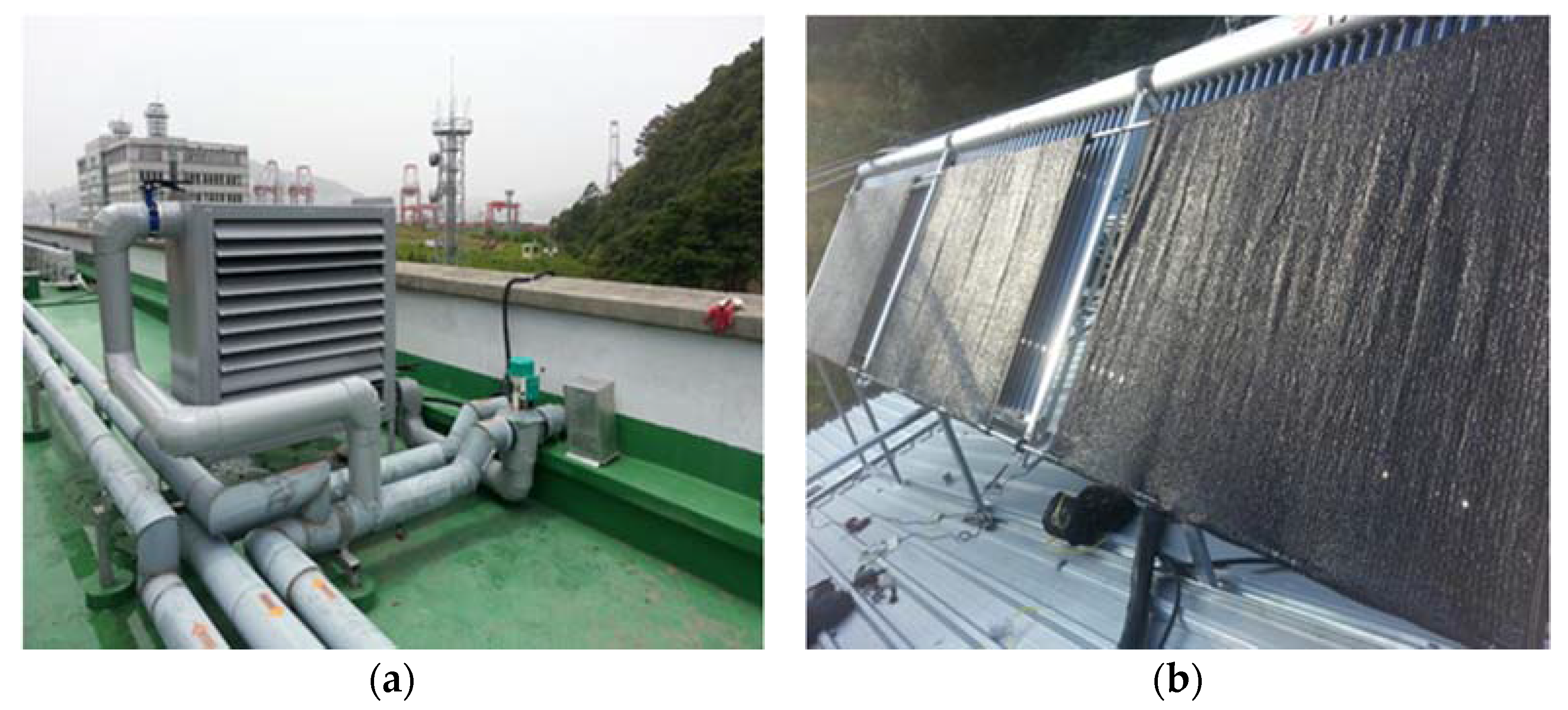
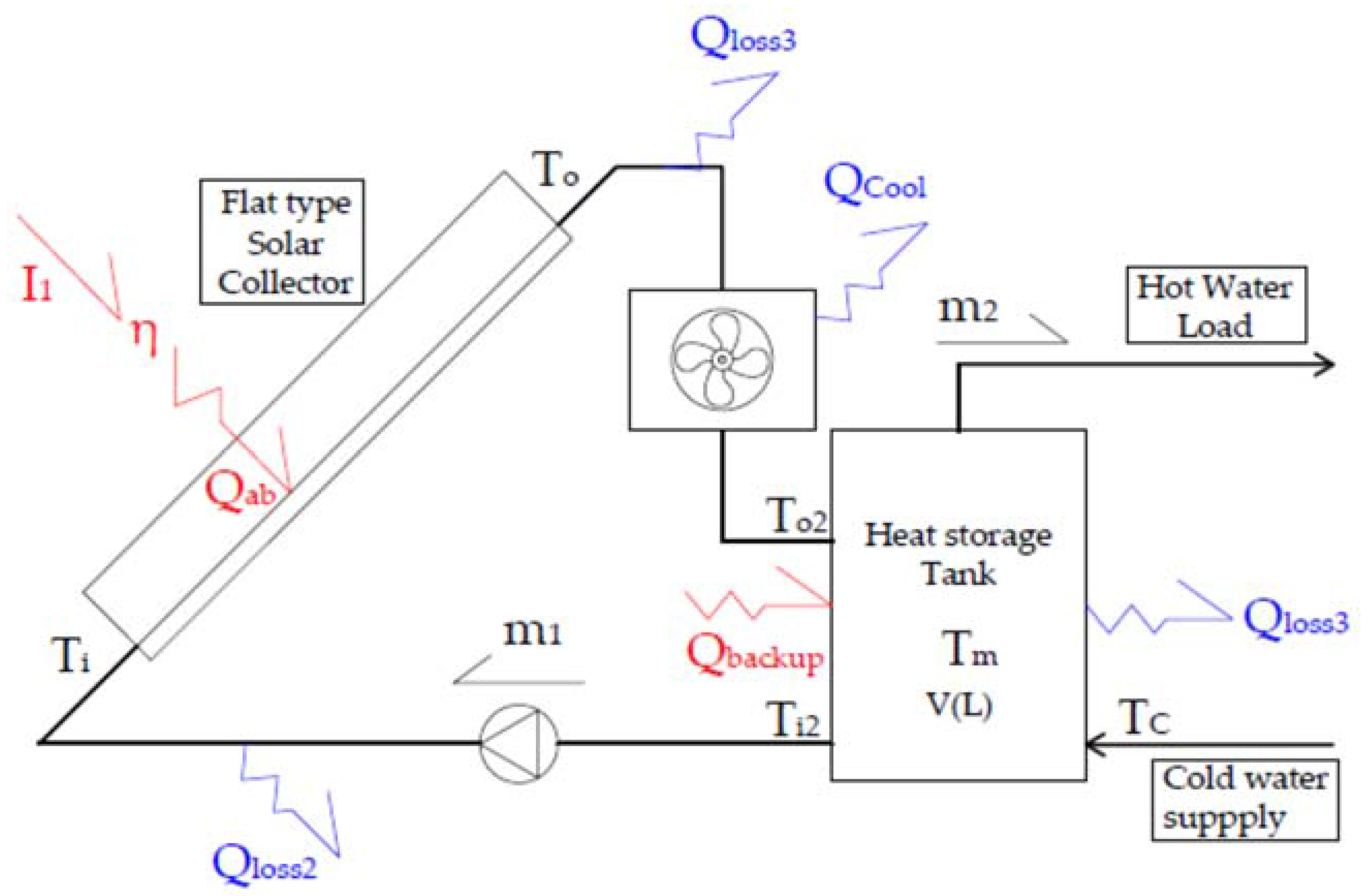
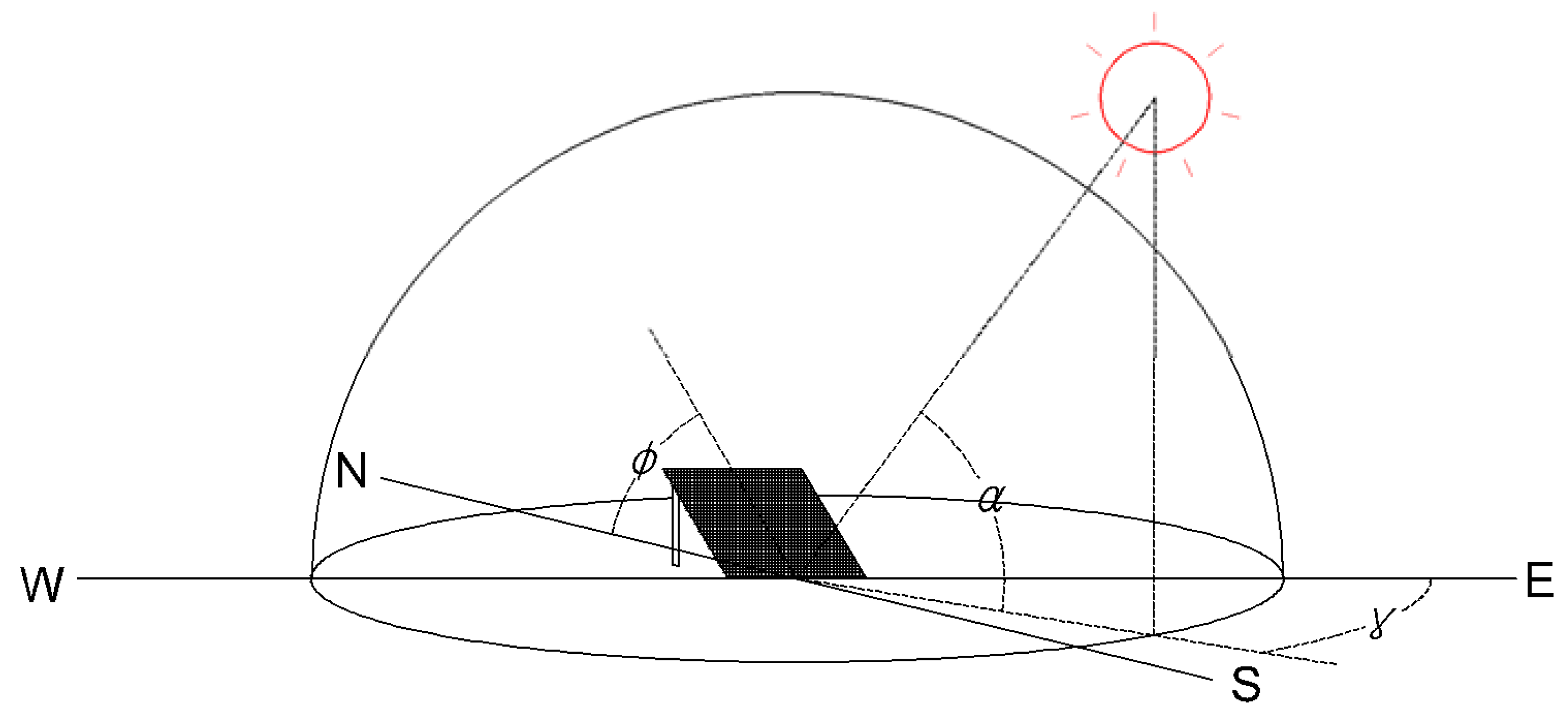
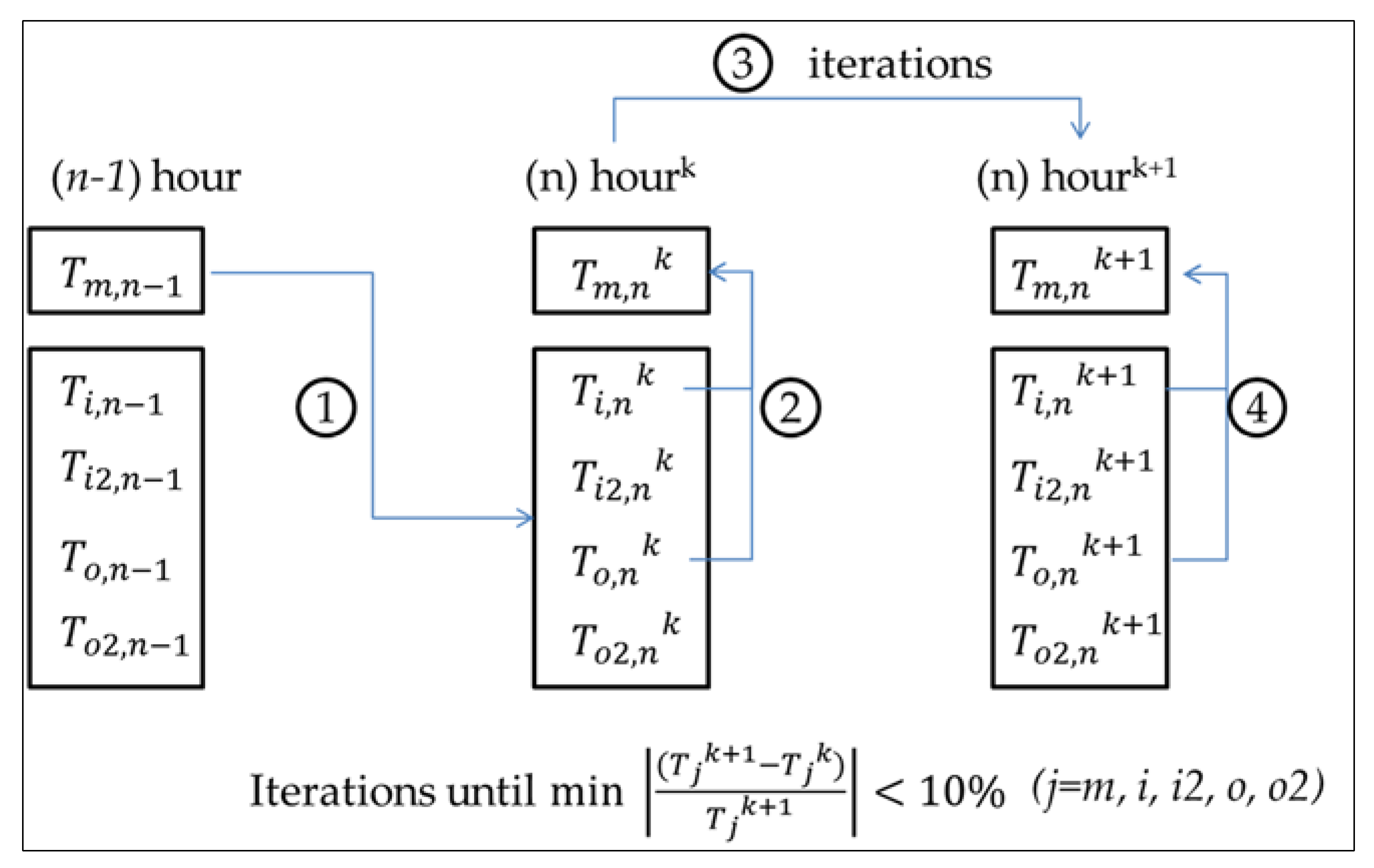
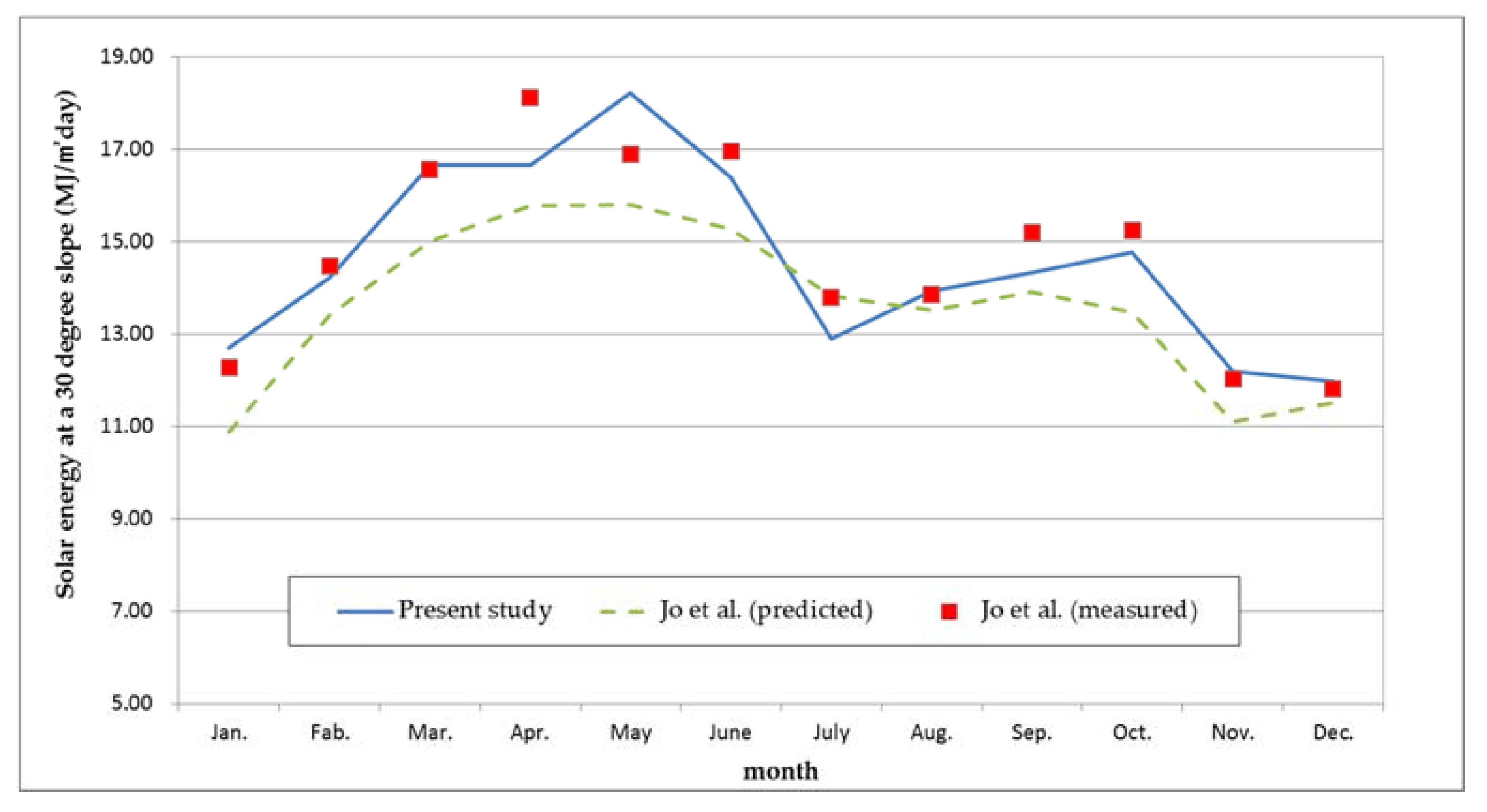
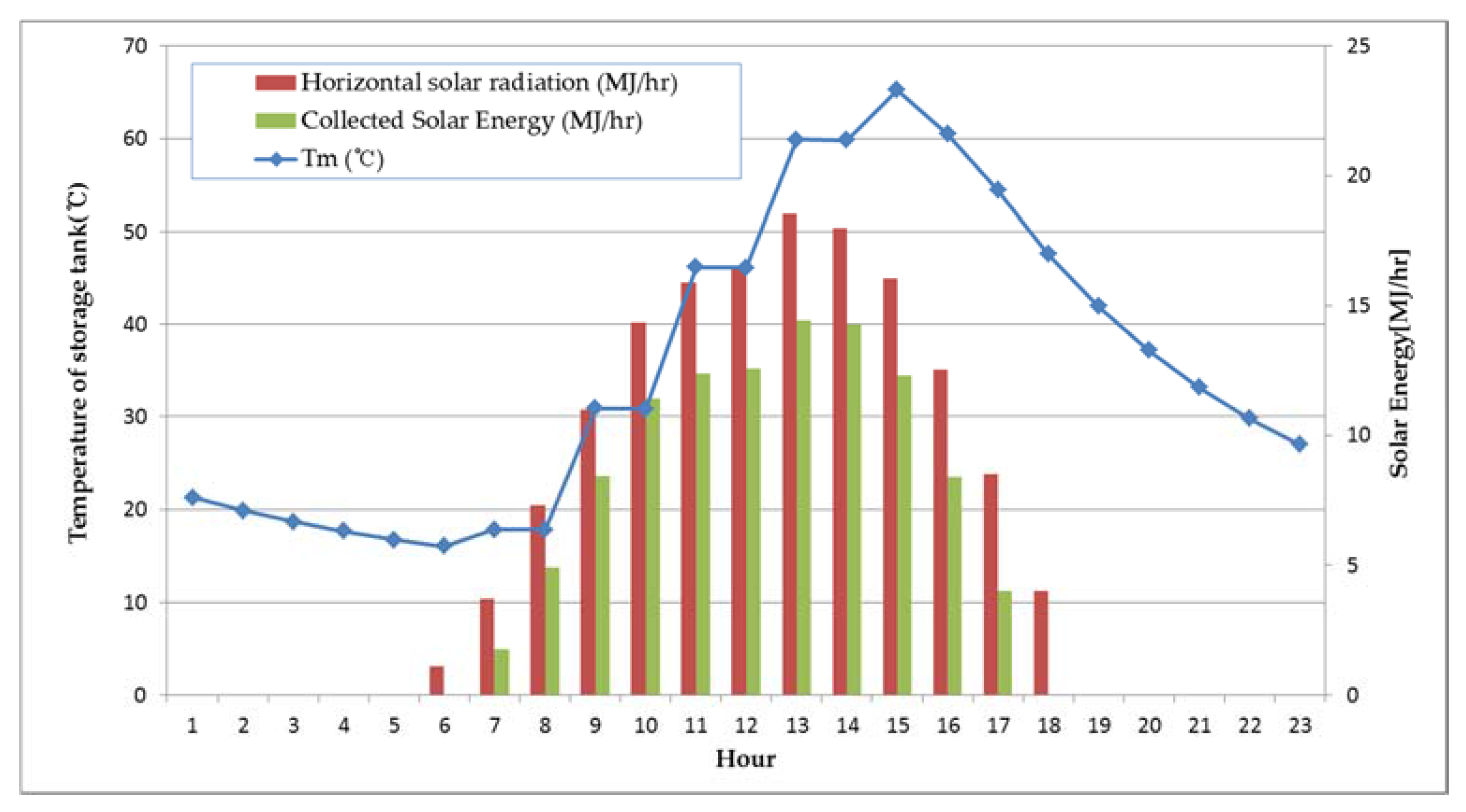

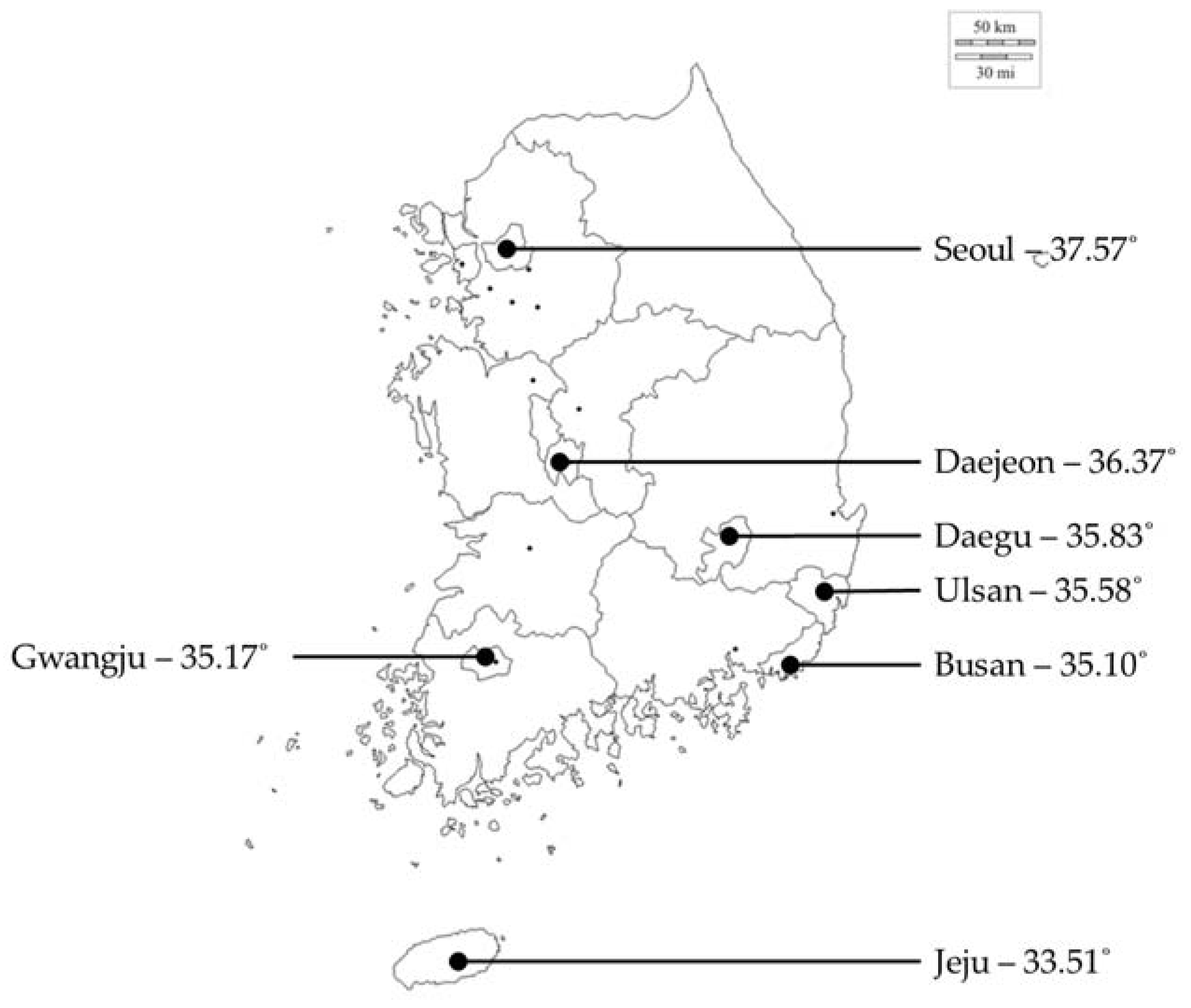

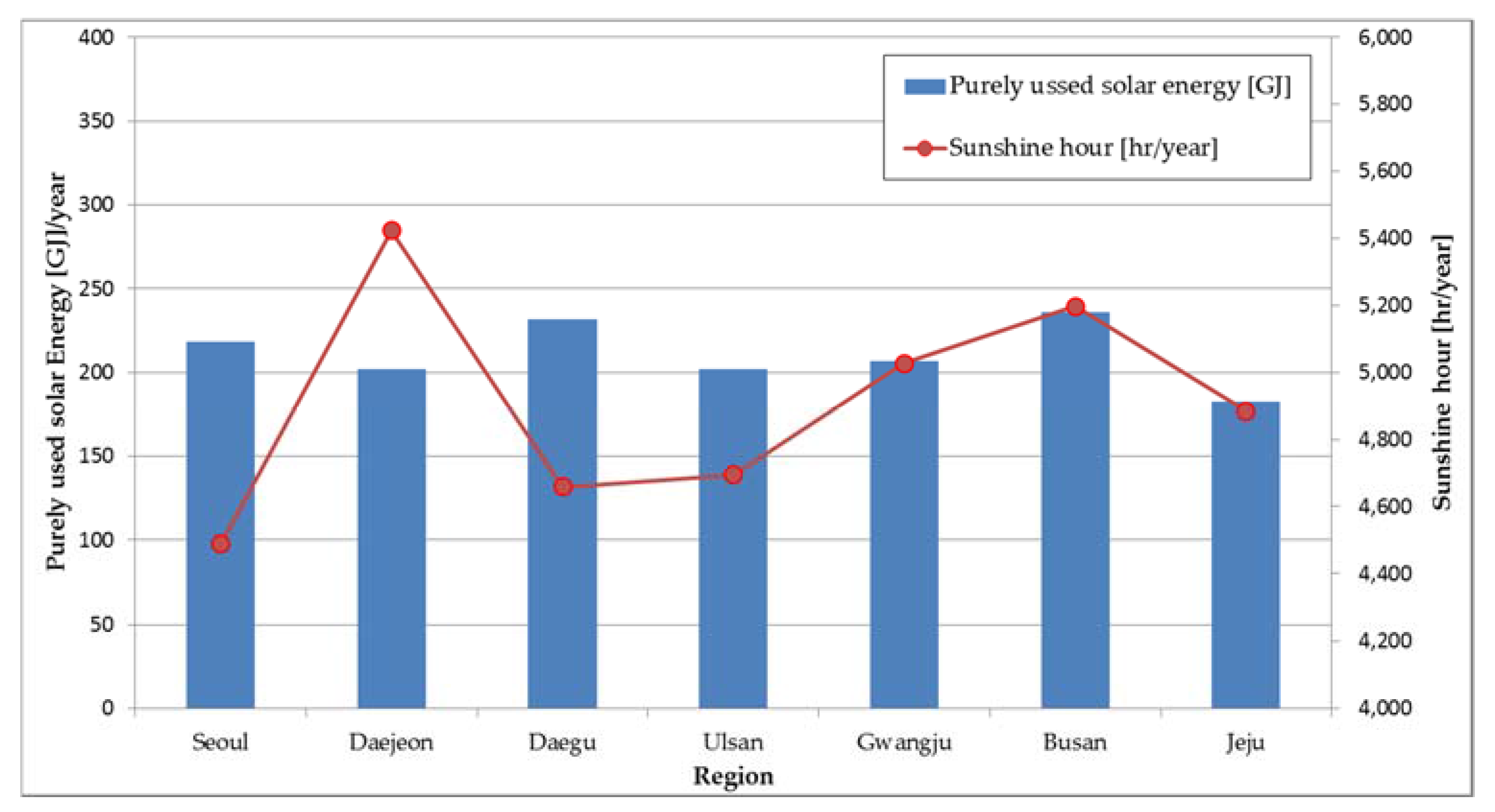
| Item | Flat-Plate Type | Single Vacuum Tube | Reflector Double Vacuum Tube |
|---|---|---|---|
| 0.771 ± 0.058 | 0.721 ± 0.007 | 0.664 ± 0.078 | |
| 5.091 ± 0.611 | 1.483 ± 0.758 | 2.829 ± 1.996 | |
| 0.0048 ± 0.0071 | 0.0055 ± 0.0047 | −0.0005 ± 0.0126 |
| Hour | 8 | 9 | 10 | 11 | 12 | 13 | 14 | 15 | 16 | 17 | 18 | Other Time |
|---|---|---|---|---|---|---|---|---|---|---|---|---|
| Occupancy ( | 0.1 | 0.25 | 0.75 | 1 | 1 | 0.5 | 0.5 | 1 | 1 | 0.5 | 0.5 | 0 |
| Month | Daily Mean Solar Radiation (MJ/m2·d) Present Study | Mean Efficiency (η) | Amount of Heat Collection (MJ/m2·d) | Amount of Heat Released due to Overheating (kJ) | Remarks |
|---|---|---|---|---|---|
| 1 | 15.19 | 0.44 | 6.75 | - | Heat collection area: 6 Capacity of the heat storage tank: 300 L |
| 2 | 16.22 | 0.46 | 7.45 | - | |
| 3 | 18.29 | 0.48 | 8.75 | - | |
| 4 | 17.76 | 0.49 | 8.62 | - | |
| 5 | 19.08 | 0.50 | 9.47 | 1.628 | |
| 6 | 16.81 | 0.48 | 8.14 | - | |
| 7 | 13.38 | 0.47 | 6.29 | - | |
| 8 | 14.75 | 0.49 | 7.27 | 1.628 | |
| 9 | 15.50 | 0.48 | 7.47 | 1.628 | |
| 10 | 16.54 | 0.47 | 7.80 | - | |
| 11 | 14.32 | 0.45 | 6.47 | - | |
| 12 | 14.47 | 0.43 | 6.23 | - | |
| Avg./Sum | 16.03 (Avg.) | 0.47 (Avg.) | 7.56 (Avg.) | 4.884 (Sum) |
| Classification | Details | |
|---|---|---|
| Installation angle | 0, 15°, 30°, 45°, 60°, 75°, 90° | |
| Heat release capacity | 14,000 kcal/h | |
| Solar collector | Type | Flat type |
| Size | 1180 mm × 2400 mm × 92 mm | |
| Quantities | 40 EA | |
| Glass | Low-iron glass (transmit rate: 91.7%) with 4 mm thickness | |
| Absorber | Titanium coated copper plate (emission rate: 4 ± 1%, Absorption rate: 95 ± 1%) with 0.2 mm thickness | |
| Insulation | Glass wool 0.040 W/mK with 40 mm thickness (bottom) PE form 0.035 W/mK with 15 mm thickness (side) | |
| Pipe | ϕ 22.2 mm * 2 EA and ϕ 8 mm × 10 EA | |
| Solar storage tank | Case A: 30 L/ (ϕ 1300 × 1200 H) Case B: 40 L/ (ϕ 1500 × 1200 H) Case C: 50 L/ (ϕ 1680 × 1200 H) (100 mm glass wool insulation) | |
| Supply and Return Pipe | 40 mm copper pipe with 40 mm insulation Length of supply pipe: 40 m Length of return pipe: 40 m | |
| Region | 1 | 2 | 3 | 4 | 5 | 6 | 7 | 8 | 9 | 10 | 11 | 12 | Total |
|---|---|---|---|---|---|---|---|---|---|---|---|---|---|
| Seoul | 8.5 | 12.3 | 15.2 | 17.6 | 21.0 | 20.2 | 14.3 | 15.0 | 14.5 | 12.4 | 8.4 | 7.7 | 167.0 |
| Daejeon | 7.7 | 11.4 | 14.4 | 16.9 | 20.4 | 19.0 | 14.7 | 14.7 | 13.1 | 11.2 | 7.8 | 7.0 | 158.5 |
| Daegu | 9.8 | 12.5 | 15.5 | 18.2 | 21.8 | 18.8 | 16.7 | 15.4 | 13.6 | 12.3 | 9.2 | 8.4 | 172.3 |
| Ulsan | 8.2 | 11.7 | 14.5 | 17.2 | 20.2 | 17.2 | 14.5 | 14.4 | 13.8 | 11.9 | 8.4 | 7.2 | 159.3 |
| Gwangju | 8.6 | 12.1 | 14.6 | 16.5 | 19.1 | 18.5 | 13.2 | 14.0 | 13.7 | 12.2 | 8.6 | 7.8 | 158.9 |
| Busan | 10.4 | 12.8 | 15.4 | 17.8 | 20.0 | 16.5 | 16.5 | 16.4 | 14.4 | 12.8 | 9.9 | 9.3 | 172.3 |
| Jeju | 6.5 | 9.9 | 13.3 | 16.2 | 18.6 | 13.8 | 16.3 | 15.5 | 13.0 | 10.9 | 7.5 | 5.9 | 147.4 |
| Case | Region | 0° | 15° | 30° | 45° | 60° | 75° | 90° |
|---|---|---|---|---|---|---|---|---|
| A | Seoul | 179.1 | 209.2 | 226.6 | 226.2 | 212.6 | 186.5 | 148.4 |
| Daejeon | 174 | 198.4 | 214 | 213.5 | 199.2 | 173.4 | 137.1 | |
| Daegu | 193.2 | 225.2 | 238.4 | 236.4 | 220.6 | 193.2 | 154 | |
| Ulsan | 171.7 | 199.8 | 213 | 211.2 | 196.3 | 170 | 134 | |
| Gwangju | 179.2 | 203.2 | 218.2 | 215.9 | 200.9 | 175.2 | 138.7 | |
| Busan | 197.3 | 228 | 240.2 | 237.9 | 222 | 194 | 155.2 | |
| Jeju | 168.9 | 186.6 | 195.5 | 190.8 | 177.3 | 152.2 | 118.2 | |
| B | Seoul | 190.5 | 216.9 | 235.5 | 235.4 | 220.4 | 192 | 152 |
| Daejeon | 184.1 | 209.3 | 223.3 | 221.2 | 206.1 | 177.6 | 136.8 | |
| Daegu | 202.6 | 232.1 | 248.3 | 246.5 | 229.7 | 200 | 155.8 | |
| Ulsan | 181.5 | 205.6 | 220.7 | 218.3 | 202.6 | 174.5 | 135.1 | |
| Gwangju | 191.1 | 213.7 | 227.2 | 224.8 | 208.5 | 179.8 | 140.1 | |
| Busan | 202.7 | 236.1 | 250.6 | 248.2 | 231.3 | 201 | 160.3 | |
| Jeju | 172.5 | 194.1 | 203.9 | 200.5 | 184.3 | 156.5 | 121.6 | |
| C | Seoul | 195.3 | 224.1 | 237.1 | 238.9 | 224.1 | 193.7 | 148.5 |
| Daejeon | 189 | 212.3 | 222.1 | 221.6 | 206.1 | 175.9 | 133.3 | |
| Daegu | 209.2 | 237 | 252 | 251 | 233.4 | 200.2 | 153.7 | |
| Ulsan | 187.1 | 212.9 | 223.3 | 221.7 | 205.5 | 174.5 | 131.5 | |
| Gwangju | 195.1 | 217.6 | 227.5 | 226.8 | 209.5 | 178.9 | 135.8 | |
| Busan | 210.8 | 239.5 | 255.5 | 253.2 | 235.6 | 203.3 | 159.1 | |
| Jeju | 179.9 | 200.4 | 208.6 | 203.6 | 186.5 | 158.6 | 121.2 |
| Case | Region | 0 | 15° | 30° | 45° | 60° | 75° | 90° |
|---|---|---|---|---|---|---|---|---|
| A | Seoul | 13.8 | 10.7 | 10.5 | 9.9 | 9.9 | 10.8 | 13.4 |
| Daejeon | 15.6 | 11.1 | 11.3 | 11.1 | 11.3 | 12.3 | 15.8 | |
| Daegu | 12.1 | 10.8 | 9.6 | 8.9 | 9 | 9.9 | 12.7 | |
| Ulsan | 14.3 | 11.9 | 10.9 | 10.4 | 10.4 | 11.6 | 15.8 | |
| Gwangju | 13.7 | 10.5 | 10.8 | 10.4 | 10.6 | 11.9 | 15.6 | |
| Busan | 11.5 | 10 | 8.6 | 8.1 | 8.2 | 9.1 | 12.3 | |
| Jeju | 14.7 | 10.7 | 10.1 | 9.6 | 10.7 | 12.4 | 16.9 | |
| B | Seoul | 28 | 17 | 16.6 | 15.7 | 16 | 17.9 | 23.4 |
| Daejeon | 29.1 | 20.8 | 18.8 | 17.8 | 18.6 | 20.6 | 25.1 | |
| Daegu | 21.9 | 16.1 | 15.3 | 14.5 | 14.8 | 16.9 | 20.5 | |
| Ulsan | 27.2 | 17.7 | 17.1 | 16.1 | 16.7 | 19.5 | 26 | |
| Gwangju | 27.3 | 18.4 | 17.4 | 16.9 | 17.5 | 19.8 | 25.7 | |
| Busan | 18.1 | 15.7 | 14 | 13.1 | 13.6 | 15.5 | 21.9 | |
| Jeju | 22.9 | 18 | 16.9 | 17.4 | 18.5 | 21.6 | 30.5 | |
| C | Seoul | 40.6 | 26.9 | 20.7 | 21.2 | 22.5 | 25.1 | 29.7 |
| Daejeon | 42.4 | 28.3 | 21.8 | 21.9 | 23.2 | 26.2 | 31.7 | |
| Daegu | 34.1 | 22.5 | 20.1 | 19.8 | 20.4 | 22.4 | 26.8 | |
| Ulsan | 40.6 | 28.7 | 22.7 | 22 | 23.7 | 26.8 | 33.3 | |
| Gwangju | 39.3 | 26.2 | 21.2 | 21.8 | 22.9 | 26.2 | 32.1 | |
| Busan | 29.2 | 20.4 | 18.9 | 18.2 | 19.1 | 22 | 29.5 | |
| Jeju | 37.6 | 28.5 | 25.4 | 24.7 | 27 | 32.4 | 42.9 |
| Case | Region | 0 | 15° | 30° | 45° | 60° | 75° | 90° |
|---|---|---|---|---|---|---|---|---|
| A | Seoul | 14.5 | 18.2 | 18.6 | 14.4 | 6.9 | 1.9 | 0.1 |
| Daejeon | 12.3 | 15.8 | 14.7 | 10.4 | 3.2 | 0.4 | 0 | |
| Daegu | 18.3 | 22.8 | 22.6 | 17.6 | 8 | 1.5 | 0.1 | |
| Ulsan | 9.9 | 12.6 | 12.2 | 8.5 | 3.6 | 0.8 | 0 | |
| Gwangju | 12.6 | 15.6 | 15.3 | 10.8 | 4.3 | 0.8 | 0 | |
| Busan | 16.1 | 20.5 | 20.3 | 16.3 | 8.5 | 2.1 | 0 | |
| Jeju | 11 | 12.6 | 11.6 | 7.2 | 2.2 | 0.1 | 0 | |
| B | Seoul | 5.5 | 7.4 | 7.8 | 4.9 | 1.6 | 0.2 | 0 |
| Daejeon | 4.9 | 6.1 | 4.8 | 1.9 | 0.2 | 0 | 0 | |
| Daegu | 9 | 10.2 | 9.7 | 5.6 | 1.3 | 0 | 0 | |
| Ulsan | 2.8 | 3.4 | 3.8 | 1.8 | 0.7 | 0 | 0 | |
| Gwangju | 5 | 6 | 5.4 | 2.7 | 0.6 | 0 | 0 | |
| Busan | 6.6 | 8.8 | 8.5 | 5.5 | 1.5 | 0.2 | 0 | |
| Jeju | 4.5 | 4.9 | 3.9 | 1.8 | 0.1 | 0 | 0 | |
| C | Seoul | 1.4 | 2.2 | 1.7 | 0.8 | 0.1 | 0 | 0 |
| Daejeon | 1.3 | 1.6 | 0.7 | 0.1 | 0 | 0 | 0 | |
| Daegu | 3.2 | 4.1 | 2.8 | 0.9 | 0 | 0 | 0 | |
| Ulsan | 0.5 | 0.6 | 0.5 | 0.2 | 0 | 0 | 0 | |
| Gwangju | 1.2 | 1.9 | 1.1 | 0.3 | 0 | 0 | 0 | |
| Busan | 2.6 | 3.4 | 2.5 | 1.2 | 0.2 | 0 | 0 | |
| Jeju | 1.8 | 2.1 | 1.2 | 0.3 | 0 | 0 | 0 |
| Case | Region | 0 | 15° | 30° | 45° | 60° | 75° | 90° |
|---|---|---|---|---|---|---|---|---|
| A | Seoul | 150.8 | 180.4 | 197.5 | 202 | 195.8 | 173.8 | 135 |
| Daejeon | 146.1 | 171.6 | 188.1 | 192 | 184.6 | 160.7 | 121.3 | |
| Daegu | 162.8 | 191.7 | 206.2 | 209.9 | 203.7 | 181.8 | 141.3 | |
| Ulsan | 147.5 | 175.3 | 189.9 | 192.3 | 182.3 | 157.6 | 118.2 | |
| Gwangju | 152.9 | 177.1 | 192.2 | 194.8 | 186 | 162.5 | 123.2 | |
| Busan | 169.7 | 197.5 | 211.3 | 213.5 | 205.3 | 182.8 | 142.9 | |
| Jeju | 143.2 | 163.3 | 173.9 | 174.1 | 164.4 | 139.7 | 101.3 | |
| B | Seoul | 157 | 192.5 | 211.1 | 214.8 | 202.9 | 173.9 | 128.6 |
| Daejeon | 150.1 | 182.5 | 199.6 | 201.5 | 187.3 | 157 | 111.7 | |
| Daegu | 171.7 | 205.8 | 223.3 | 226.4 | 213.5 | 183.1 | 135.2 | |
| Ulsan | 151.5 | 184.5 | 199.9 | 200.4 | 185.2 | 155.1 | 109.2 | |
| Gwangju | 158.8 | 189.3 | 204.3 | 205.1 | 190.4 | 160 | 114.4 | |
| Busan | 177.9 | 211.7 | 228.1 | 229.5 | 216.2 | 185.2 | 138.4 | |
| Jeju | 145.2 | 171.2 | 183.1 | 181.2 | 165.7 | 134.9 | 91.1 | |
| C | Seoul | 153.3 | 195 | 214.7 | 216.9 | 201.6 | 168.5 | 118.8 |
| Daejeon | 145.3 | 182.3 | 199.6 | 199.6 | 182.9 | 149.6 | 101.5 | |
| Daegu | 172 | 210.4 | 229.1 | 230.3 | 213 | 177.8 | 126.9 | |
| Ulsan | 146 | 183.6 | 200.1 | 199.5 | 181.8 | 147.7 | 98.2 | |
| Gwangju | 154.5 | 189.5 | 205.2 | 204.6 | 186.6 | 152.7 | 103.6 | |
| Busan | 179 | 215.6 | 234 | 233.8 | 216.3 | 181.3 | 129.6 | |
| Jeju | 140.5 | 169.8 | 182 | 178.6 | 159.5 | 126.2 | 78.3 |
| 1st Step | 2nd Step | ||||
|---|---|---|---|---|---|
| Region | Capacity (L/) | Optimum Angle (°) | Effective Amount of Heat Collection (GJ/year) | Optimum Angle (°) | Effective Amount of Heat Collection (GJ/year) |
| Seoul | 50 | 45 | 216.9 | 39 | 218.3 |
| Daejeon | 40 | 45 | 201.5 | 39 | 202.8 |
| Daegu | 50 | 45 | 230.3 | 38 | 232.0 |
| Ulsan | 50 | 45 | 200.4 | 37 | 202.4 |
| Gwangju | 50 | 30 | 205.2 | 36 | 207.1 |
| Busan | 50 | 30 | 234.0 | 38 | 236.3 |
| Jeju | 40 | 30 | 183.1 | 37 | 184.2 |
| Region | Latitude (°) | Optimum Angle (°) | Effective Amount of Heat Collection (GJ) | Difference in Angle (°) |
|---|---|---|---|---|
| Seoul | 37.57 | 39 | 218.3 | 1.4 |
| Daejeon | 36.37 | 38 | 202.1 | 1.6 |
| Daegu | 35.83 | 39 | 232.0 | 3.2 |
| Ulsan | 35.58 | 37 | 202.4 | 1.4 |
| Gwangju | 35.17 | 38 | 207.1 | 2.8 |
| Busan | 35.10 | 38 | 236.3 | 2.9 |
| Jeju | 33.51 | 35 | 182.7 | 1.5 |
| Mean | - | - | - | 2.1 |
| Region | Latitude (°) | Angle (°) | Effective Amount of Heat Collection (GJ/Year) | Difference in Angle (°) |
|---|---|---|---|---|
| Seoul | 37.6 | 41 | 165.5 | 3.4 |
| Daejeon | 36.4 | 41 | 150.1 | 4.6 |
| Daegu | 35.8 | 42 | 154.9 | 6.2 |
| Ulsan | 35.6 | 40 | 152.8 | 4.4 |
| Gwangju | 35.2 | 40 | 154.8 | 4.8 |
| Busan | 35.1 | 39 | 179.6 | 3.9 |
| Jeju | 33.5 | 36 | 128.3 | 2.5 |
| Average | - | - | - | 4.26 |
© 2017 by the authors. Licensee MDPI, Basel, Switzerland. This article is an open access article distributed under the terms and conditions of the Creative Commons Attribution (CC BY) license (http://creativecommons.org/licenses/by/4.0/).
Share and Cite
Jun, Y.-J.; Song, Y.-H.; Kim, D.-Y.; Park, K.-S. Analysis of the Optimum Solar Collector Installation Angle from the Viewpoint of Energy Use Patterns. Energies 2017, 10, 1753. https://doi.org/10.3390/en10111753
Jun Y-J, Song Y-H, Kim D-Y, Park K-S. Analysis of the Optimum Solar Collector Installation Angle from the Viewpoint of Energy Use Patterns. Energies. 2017; 10(11):1753. https://doi.org/10.3390/en10111753
Chicago/Turabian StyleJun, Yong-Joon, Young-Hak Song, Dae-Young Kim, and Kyung-Soon Park. 2017. "Analysis of the Optimum Solar Collector Installation Angle from the Viewpoint of Energy Use Patterns" Energies 10, no. 11: 1753. https://doi.org/10.3390/en10111753





